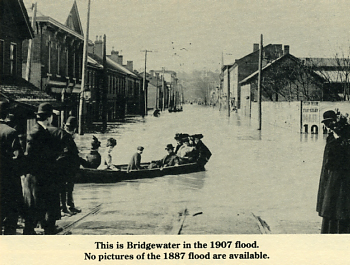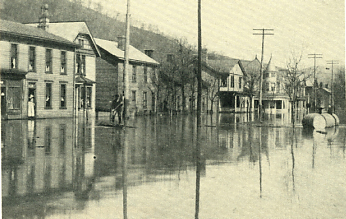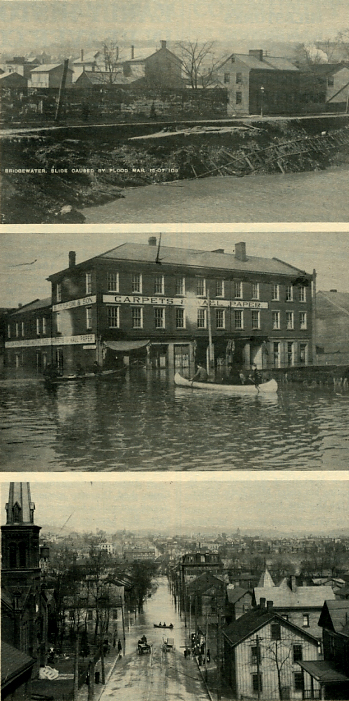
Click Here to Return to Weather Index
Click Here to Return to Disasters Index
Click Here to Return To Milestones Vol 21 No 4
The late thaw and rains had caused the Ohio River and Beaver Creek to be assuming for some days previous at a very threatening stage. All day Tuesday the water rose rapidly and when darkness covered the face of the mighty deep and the residents living along the banks of the Ohio in Rochester and the surrounding towns retired Tuesday night it was with the unpleasant project of having to swim ashore next morning that caused them to carry a life preserver or plank to bed with them.
Many of the residents, especially those on Water Street, realizing that the water would soon be upon them, spent the night in removing their household goods to the upper stories of their houses. When the mists had cleared away this morning a watery panorama was presented. The rushing waters were not only full from bank to bank, but along Water Street had overflowed, and almost the entire area constituting the flats south of the railroad track, from the Point Bottle Works to New York Street was from two to six feet under water.
All the business houses as well as the residences along Water Street were badly submerged before 10 o'clock Tuesday morning with the exception of Speyerer's store and Mrs. Eble's residence, which occupy more elevated sites. As the river was still rising at the alarming rate of ten inches an hour at ten o'clock, all was soon under water.

Last night the Big Beaver and the Ohio continued rising at about eight inches an hour. The heavy rain of the night and during the day together with the already raging waters, produced conditions for a flood seldom happening, and people predicted a rise in both the Big Beaver and Ohio that would beat the record of 1832, the highest water known in this region, and the story of which is yet related by the oldest inhabitants as one of the wonders of high water only surpassed by Noah's flood. There is a fascination about floods that has great power over the imagination. The angry waters are such a demonstration of destructive force that people are constrained to behold its power with a feeling of awe, akin to that which would be inspired by an earthquake, or volcano, or any other of nature's angry moods the force of which could not be measured or the danger of which determined.
Yesterday afternoon the people flocked to the high banks skirting the rivers, excited and awe stricken by the terrible scene that was being enacted in the valleys below.
There was a vast expanse of waters. The Ohio had overflowed its banks and covered the low ground up to the railroad track on the north side. Bridgewater was inundated and nearly every home and store had water in on the first floor, and some of those on lower ground were filled to the second story. The water in Bridge Street between the Presbyterian church and Dougherty's shoe store was from 4 to 5 feet deep and the current so strong at 5 o'clock in the evening that it was difficult to ford it even with a horse.
The Bridgewater Presbyterian church was surrounded with water which reached to the base of Beaver hill and extended up the valley as far as the eye could penetrate. All the houses were surrounded with water and the place which but a few hours before presented a hamlet of peaceful, happy and comfortable homes, looked woe-begone and desolate, the houses being rapidly deserted and left to suffer an unknown fate. The water rose so rapidly that it was impossible to remove a great deal of property, and hence the loss of goods, groceries and other stock in the stores, and provisions and household goods in the homes was very great.

The greatest interest centered in the toll bridge for fear it would be swept away. In the evening word was received from Pittsburgh that there was from 3 to 4 feet more water coming, and from Youngstown that it was raining and the river was still rising. Thousands of people thronged the banks on either side of the river, expecting to see the bridge go. It was known that the Fallston bridge was in great danger, as some of its arches had already given away, and it was believed that it might come down at any moment against the Bridgewater bridge, and if it did, would carry it away also, and the C. & P. bridge below. Many predictions were made as to whether it would go or stay, but the majority inclined to the opinion that it must give way during the night. Captain George Hamilton, of Beaver, was one of the most hopeful, as he stoutly maintained that since the bridge withstood the flood of 1832, it wouldn't yield now. "Men," said he, "it won't go." Someone suggested that the water was higher now than it was in 1832. "Not a bit of it," said he. "It is not as high as it was then and you take my word for it the bridge will not go." About 2 o'clock in the night the Fallston bridge came moving down slowly as seen by a few persons on the Rochester side, who were watching for the expected event. It struck the bridge with tremendous momentum and made a terrible crash, but did its work of destruction laughing to scorn the puny resistance of man to stop its power. The two bridges then together were carried down by the current against the C. & P. railroad bridge, which spans the creek near its mouth and tore a passage through it, swinging the western end round like the opening of a gate and leaving it fastened to the Rochester end, where it now is twisted and broken and useless. The noise of the crashing timbers was terrific, and heard at a great distance. Five spans of the Beaver end of the P. & L E. railroad were washed away sometime during the night having been struck by parts of a floating bridge.
The loss to the Big Beaver Bridge Company is about $25,000. The amount of damages to the other bridges is unknown.
The Big Beaver bridge was chartered in 1814, and built by William Le Baron, who also built the Fallston and New Brighton bridges. It was washed away in 1825, and soon afterwards rebuilt. The company owns the franchise of 300 feet above and below the bridge and will call a meeting at once to consider the question of rebuilding the same.

Benjamin Buckley, of Bridgewater, called two hours for help Wednesday night to save him from drowning, but his cries were not answered until there was a foot of water on his roof.
At Industry several houses have been swept away, and all along the valley between here and there the destruction of property is great.
The scene along Water Street, Rochester, is one that beggars description. Men, women and children have been busily engaged trying to save their household goods by means of skiffs and floats. The outhouses are overturned; strangers obliged to abandon the cars, and thousands of people from the surrounding towns act as spectators.
At the residence of John Whistler in Bolesville Thursday the water in the Beaver Creek reached the highest stage within the memory of the oldest inhabitant now living. During the flood of 1832 the highest point reached was plainly marked upon Mr. Whistler's residence. On last Wednesday night the water reached the highest water mark indicated, and on Thursday ascended higher up until a point just fifteen inches above the mark of 1832 had been reached. Mr. Whistler having placed the mark in 1832 and resided in the same house ever since, this record of comparisons of the great floods may be relied upon as being strictly true.
Judge Hice, John M. Buchanan, Esq., and Capt. W. P. McConnel, of Beaver, and Dr. Addison Libby, of this place, in order to reach home Wednesday evening, took a train on the Ft. Wayne Road, but only got as far as Leetsdale. There they procured a skiff, and landed at the Rochester Tumbler Works. From there they wandered to and across the toll bridge, but found only the raging waters to convey them to Beaver hill. Then they wearily retraced their steps, and finally crossed the C. & P. railroad bridge.